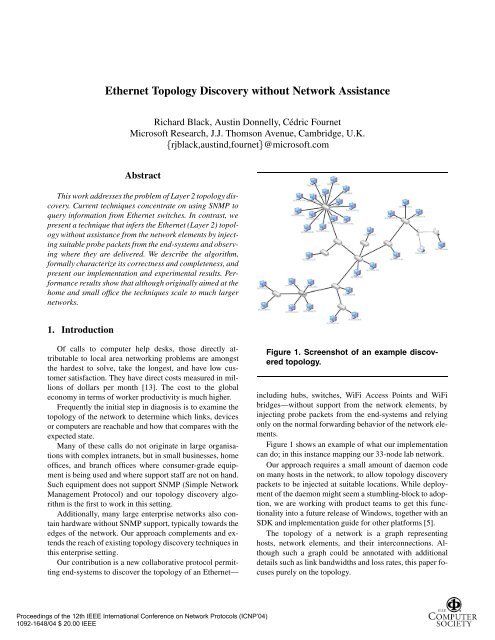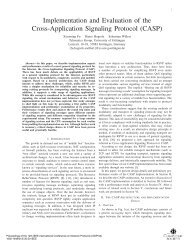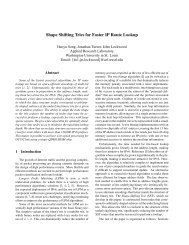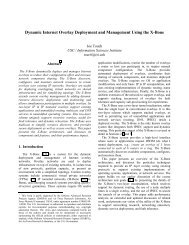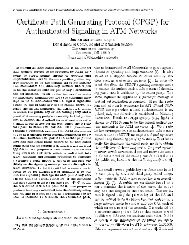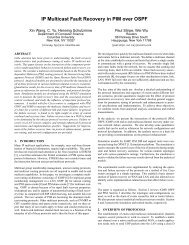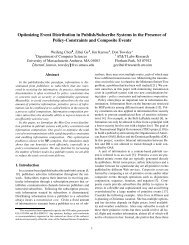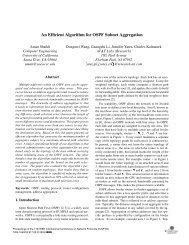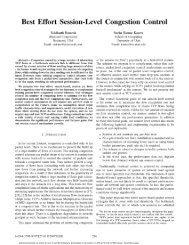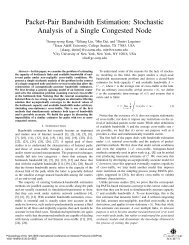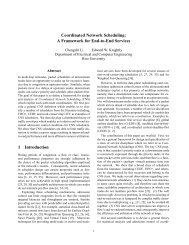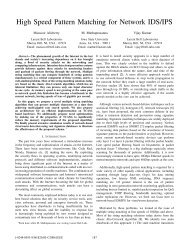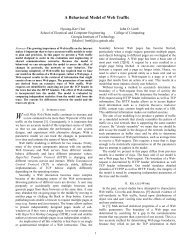Ethernet topology discovery without network assistance ... - ICNP
Ethernet topology discovery without network assistance ... - ICNP
Ethernet topology discovery without network assistance ... - ICNP
Create successful ePaper yourself
Turn your PDF publications into a flip-book with our unique Google optimized e-Paper software.
<strong>Ethernet</strong> Topology Discovery <strong>without</strong> Network Assistance<br />
Richard Black, Austin Donnelly, Cédric Fournet<br />
Microsoft Research, J.J. Thomson Avenue, Cambridge, U.K.<br />
rjblack,austind,fournet@microsoft.com<br />
Abstract<br />
This work addresses the problem of Layer 2 <strong>topology</strong> <strong>discovery</strong>.<br />
Current techniques concentrate on using SNMP to<br />
query information from <strong>Ethernet</strong> switches. In contrast, we<br />
present a technique that infers the <strong>Ethernet</strong> (Layer 2) <strong>topology</strong><br />
<strong>without</strong> <strong>assistance</strong> from the <strong>network</strong> elements by injecting<br />
suitable probe packets from the end-systems and observing<br />
where they are delivered. We describe the algorithm,<br />
formally characterize its correctness and completeness, and<br />
present our implementation and experimental results. Performance<br />
results show that although originally aimed at the<br />
home and small office the techniques scale to much larger<br />
<strong>network</strong>s.<br />
1. Introduction<br />
Of calls to computer help desks, those directly attributable<br />
to local area <strong>network</strong>ing problems are amongst<br />
the hardest to solve, take the longest, and have low customer<br />
satisfaction. They have direct costs measured in millions<br />
of dollars per month [13]. The cost to the global<br />
economy in terms of worker productivity is much higher.<br />
Frequently the initial step in diagnosis is to examine the<br />
<strong>topology</strong> of the <strong>network</strong> to determine which links, devices<br />
or computers are reachable and how that compares with the<br />
expected state.<br />
Many of these calls do not originate in large organisations<br />
with complex intranets, but in small businesses, home<br />
offices, and branch offices where consumer-grade equipment<br />
is being used and where support staff are not on hand.<br />
Such equipment does not support SNMP (Simple Network<br />
Management Protocol) and our <strong>topology</strong> <strong>discovery</strong> algorithm<br />
is the first to work in this setting.<br />
Additionally, many large enterprise <strong>network</strong>s also contain<br />
hardware <strong>without</strong> SNMP support, typically towards the<br />
edges of the <strong>network</strong>. Our approach complements and extends<br />
the reach of existing <strong>topology</strong> <strong>discovery</strong> techniques in<br />
this enterprise setting.<br />
Our contribution is a new collaborative protocol permitting<br />
end-systems to discover the <strong>topology</strong> of an <strong>Ethernet</strong>—<br />
Figure 1. Screenshot of an example discovered<br />
<strong>topology</strong>.<br />
including hubs, switches, WiFi Access Points and WiFi<br />
bridges—<strong>without</strong> support from the <strong>network</strong> elements, by<br />
injecting probe packets from the end-systems and relying<br />
only on the normal forwarding behavior of the <strong>network</strong> elements.<br />
Figure 1 shows an example of what our implementation<br />
can do; in this instance mapping our 33-node lab <strong>network</strong>.<br />
Our approach requires a small amount of daemon code<br />
on many hosts in the <strong>network</strong>, to allow <strong>topology</strong> <strong>discovery</strong><br />
packets to be injected at suitable locations. While deployment<br />
of the daemon might seem a stumbling-block to adoption,<br />
we are working with product teams to get this functionality<br />
into a future release of Windows, together with an<br />
SDK and implementation guide for other platforms [5].<br />
The <strong>topology</strong> of a <strong>network</strong> is a graph representing<br />
hosts, <strong>network</strong> elements, and their interconnections. Although<br />
such a graph could be annotated with additional<br />
details such as link bandwidths and loss rates, this paper focuses<br />
purely on the <strong>topology</strong>.<br />
Proceedings of the 12th IEEE International Conference on Network Protocols (<strong>ICNP</strong>’04)<br />
1092-1648/04 $ 20.00 IEEE
Topology <strong>discovery</strong> can be at a variety of levels, ranging<br />
from Internet-scale mapping efforts to small-scale home<br />
area <strong>network</strong>s. The techniques applicable to one effort are<br />
not necessarily transferable to others; this paper describes<br />
<strong>Ethernet</strong> (Layer 2) <strong>topology</strong> <strong>discovery</strong>.<br />
Topology <strong>discovery</strong> should ideally return the simplest<br />
<strong>network</strong> compatible with all observations. However, the potential<br />
presence of hubs and switches not directly linked to<br />
any hosts significantly complicates our task. Clearly, some<br />
elements cannot be detected by any sequence of packets—<br />
for instance, a switch attached to a single segment is invisible.<br />
More surprisingly, perhaps, it is often possible to infer<br />
the presence of hubs and switches far from any host involved<br />
in the protocol. To clarify these ideas, and gain confidence<br />
in our protocol, we formalize the observable semantics<br />
of <strong>network</strong>s and show that, in the absence of wireless elements,<br />
our <strong>discovery</strong> algorithm is correct and complete.<br />
Section 2 covers related work. Section 3 reviews the behavior<br />
of various <strong>network</strong> elements and defines our terminology<br />
and notations. Section 4 explains the algorithm, and<br />
section 5 describes some limitations, security aspects, and<br />
the extensions to wireless <strong>network</strong>ing. Section 6 considers<br />
the correctness and completeness of the algorithm. Section<br />
7 evaluates its implementation, both on real <strong>network</strong>s<br />
and in simulation. Section 8 presents our conclusions.<br />
2. Related Work<br />
Recently, there has been much research into Internetscale<br />
mapping or tomography [9, 12, 2]. These tend to be<br />
passive, non-collaborative, IP-layer protocols (although [3]<br />
like us uses active probing). For individual routes in the Internet,<br />
tools such as traceroute and pathchar [7] can be used<br />
to discover link characteristics. Mapping at this level in such<br />
a large environment is far removed from our work; it considers<br />
<strong>topology</strong> at the IP level and tends to apply to the wide<br />
area and multiple organisations, whereas our work applies<br />
to the local area (a single <strong>Ethernet</strong>), and a single organisation.<br />
Of course the techniques could be used and combined<br />
in an overall larger picture.<br />
Closer to our problem is that of mapping enterprise or<br />
datacenter <strong>network</strong>s. In this area commercial products such<br />
as IBM/Tivoli’s NetView and HP’s OpenView are common<br />
[14, 8], along with the more basic Nomad [4] and<br />
OpenNMS [1]. These mappers work by issuing SNMP<br />
queries for router tables (defined in MIB-2) [11], IEEE<br />
802.1D Bridge MIBs [6], and / or RMON-2 MIBs [15].<br />
These MIBs give information for each port on the IP router<br />
or <strong>Ethernet</strong> switch, including the hosts or <strong>network</strong> elements<br />
attached to these ports.<br />
These management interfaces have some variation in<br />
their implementation; Lowekamp et al. report needing to<br />
develop work-arounds [10] in their presentation of an efficient<br />
technique for stitching together the partial topologies<br />
resulting from SNMP queries into a consistent whole, using<br />
contradictions to quickly narrow down the possible interconnections<br />
between switches.<br />
Several problems remain with MIB based approaches:<br />
MIBs only contain information on recently active hosts<br />
(since bridges timeout address table entries after around five<br />
minutes); properly secured <strong>network</strong> elements need the mapper<br />
to supply an appropriate community string (i.e. password)<br />
before allowing access.<br />
Most significantly however, many devices especially in<br />
the application domain of interest do not support SNMP;<br />
indeed, for an ad hoc wireless <strong>network</strong> there is no device!<br />
We believe that our approach, using a careful analysis of<br />
only the fundamental packet forwarding properties of the<br />
<strong>network</strong> elements themselves, is new and provides an effective,<br />
end-system-based way to map <strong>network</strong>s.<br />
3. Terminology<br />
We introduce two new terms: islands and gaps in our<br />
discussion of <strong>network</strong> <strong>topology</strong>. However, since our approach<br />
relies on observing and analyzing the standard operational<br />
behavior of the <strong>network</strong>, we begin with a short summary<br />
of the operation of <strong>network</strong> elements before we define<br />
those terms. Section 6 gives formal definitions, in terms of<br />
simply-connected graphs and subgraphs.<br />
Hosts, Addresses, and Packets. An <strong>Ethernet</strong> is a graph<br />
with two kinds of nodes: hosts, with a single link, and <strong>network</strong><br />
elements, with multiple links. <strong>Ethernet</strong> requires that all<br />
redundant links have been eliminated (either through STP<br />
(Spanning Tree Protocol), or by wiring rules); the graph is<br />
therefore a tree, with a single path between any two nodes.<br />
Each host is characterized by its distinct MAC address,<br />
thus a computer with multiple <strong>network</strong> interfaces is treated<br />
as multiple hosts.<br />
Switches and Hubs. To the reader, it might seem clear<br />
whether a particular element is a switch or a hub, but given<br />
the abuse of terminology used in much marketing literature,<br />
we feel a hard definition is needed.<br />
Switches are devices that can dynamically learn which<br />
addresses are on each port, and filter packets destined to<br />
those addresses accordingly. Concretely, if a switch receives<br />
a packet with source on a given port, then it subsequently<br />
delivers packets for destination to that port only; packets<br />
from that port with destination are dropped. If no<br />
packet from source has been seen, then the switch floods a<br />
packet to that destination to all ports. We do not require that<br />
switches implement the IEEE 802.1D STP, since so many<br />
inexpensive switches do not.<br />
Hubs are stateless devices; they always flood received<br />
packets to all ports except the original incoming port.<br />
Proceedings of the 12th IEEE International Conference on Network Protocols (<strong>ICNP</strong>’04)<br />
1092-1648/04 $ 20.00 IEEE
Network diagrams (such as in figure 2) in use square<br />
boxes to represent <strong>network</strong> elements, with an ‘X’ for<br />
switches and an ‘H’ for hubs.<br />
Segments. We use the standard meaning of segment: a<br />
shared media where hosts overhear each others’ transmissions<br />
(e.g. a 10Base2 coax bus or at least one 10BaseT hub).<br />
A segment with at least one host is a shallow segment and<br />
considered to be at the edge of the <strong>network</strong>; segments with<br />
no hosts are called deep segments. For brevity we sometimes<br />
identify a segment with a host present on the segment.<br />
We classify segments as intermediate if a packet being<br />
put onto the segment may arrive at more than one switch. It<br />
follows that a shallow segment is intermediate if it contains<br />
at least two switches; a deep intermediate segment requires<br />
at least three switches since it has no hosts.<br />
For instance, figure 2 shows a simple <strong>network</strong> comprising<br />
four hubs and two switches, with eight hosts arranged<br />
in pairs on four segments. The segment containing <br />
is an intermediate segment.<br />
Islands and Gaps. An island consists of one or more shallow<br />
segments of the <strong>network</strong>, forming a maximal connected<br />
subgraph with no deep segments.<br />
A gap is a portion of a <strong>network</strong> containing only deep segments;<br />
it therefore connects multiple islands together.<br />
For instance, figure 2 shows a single island; figure 5<br />
shows three islands connected by two gaps (both just a<br />
wire); figures 7 and 8 illustrate more complex gaps, composed<br />
of several deep segments.<br />
Access Points. Wireless APs (Access Points) partially filter<br />
packets: they maintain a table of addresses associated<br />
with their wireless port, and transmit a packet on the wireless<br />
port only if its destination address appears in the association<br />
table (or if it is broadcast or multicast). An AP<br />
does not forward a packet to an unknown destination from<br />
its wired to its wireless interface. Packets arriving from the<br />
wireless side with a destination address that does not appear<br />
in the association table are bridged to the fixed side of<br />
the AP. We say a host is behind an AP if it is connected to<br />
the AP’s wireless side.<br />
Note that a consequence of association is that wireless<br />
clients of an AP must send packets with a source address<br />
which has previously associated: this precludes the forging<br />
of source addresses.<br />
Wireless Bridges. Wireless bridges (such as the Linksys<br />
WET11) are also devices with one wired and one wireless<br />
port: they are designed to permit one or more wired computers<br />
to associate indirectly to a wireless access point. We<br />
say that the wired computers are behind the bridge.<br />
Wireless bridges require care during <strong>discovery</strong> because<br />
hosts can appear to be connected to a fixed <strong>network</strong> when<br />
actually there is a point-to-point wireless link between them<br />
and other portion(s) of the <strong>network</strong>.<br />
We consider bridges which operate in one of two modes.<br />
In clone mode, the bridge notes the first source MAC address<br />
it receives on its fixed side, and associates to the AP<br />
using that address. This only allows a single host behind the<br />
bridge, however it provides true Layer 2 bridging semantics.<br />
In proxy mode, the bridge associates with the AP using<br />
the bridge’s own address. It performs proxy-ARP for<br />
the IP addresses on the wired side, building a table of IP<br />
and MAC addresses; when packets arrive on the wireless<br />
side, the bridge rewrites them to have the correct destination<br />
MAC address (rather than its own), and sends them<br />
out on the fixed side. Packets from the fixed side have their<br />
source MAC address rewritten to be the bridge’s own, since<br />
this is the address associated with the AP. This allows multiple<br />
IP hosts to operate behind the bridge, but does not provide<br />
true Layer 2 connectivity.<br />
4. Algorithm<br />
At a very high level the technique is based on two simple<br />
properties: (1) hosts on the same segment can be detected<br />
since in promiscuous mode each can see all the traffic<br />
of the others, and (2) a packet with a particular source address<br />
entering a switch on one port will prevent the switch<br />
from sending packets with that destination address to any<br />
other port.<br />
Assumptions. In our implementation we use a distinguished<br />
host Å, themapper, that acts as a central controlling<br />
entity for the algorithm. We also assume that most hosts<br />
in the <strong>network</strong> run a daemon that can inject <strong>topology</strong> packets<br />
and record received packets (using promiscuous mode);<br />
section 5 relaxes our assumption for some hosts.<br />
A preliminary protocol permits us to discover all hosts<br />
running daemons, and establish a control RPC connection<br />
to them. The RPC interface permits Å to request the transmission<br />
of a packet and query which packets have been observed.<br />
The mapper determines the sequence, addresses, and injection<br />
points for packet transmissions, and how such transmissions<br />
are interleaved with queries. The RPC protocol is<br />
fairly standard so hereinafter we simply assume that the algorithm<br />
directly controls all hosts. Throughout the discussion<br />
we assume that no packet loss occurs; the real implementation<br />
uses either acknowledgements (where a packet<br />
always arrives somewhere) or repetition (where a test packet<br />
may be validly not delivered anywhere) but we elide these<br />
details for clarity and space; the technique used at each<br />
stage is obvious from the discussion below.<br />
For our notation we let ÈÉ range over<br />
host MAC addresses. In addition, we sometimes rely on addresses<br />
Ä not attributed to any host on the <strong>network</strong> but<br />
instead allocated from a private range assigned for our technique.<br />
Proceedings of the 12th IEEE International Conference on Network Protocols (<strong>ICNP</strong>’04)<br />
1092-1648/04 $ 20.00 IEEE
We use the notation to mean that host <br />
sends an <strong>Ethernet</strong> packet with source address and destination<br />
address . Note that in standard <strong>Ethernet</strong> is at liberty<br />
to fake the source address, indeed we exploit this in<br />
our algorithm; because such addresses are from a private<br />
range always different from real addresses, normal traffic is<br />
not disturbed. Topology <strong>discovery</strong> packets also use a distinct<br />
<strong>Ethernet</strong> Type field to further prevent interference.<br />
In description we may distinguish training and probe<br />
packets: training packets cause a switch to learn a particular<br />
source address, whereas probe packets test whether a<br />
switch has learnt a trained address. Of course on the wire<br />
there is no difference between them.<br />
Outline. Mapping proceeds by execution and analysis of<br />
a number of phases. We initially explain the wired algorithm,<br />
and subsequently explain the extensions for wireless<br />
elements and uncooperative hosts in section 5. We also ensure<br />
that all switches know the real addresses of all hosts at<br />
the beginning of the mapping, using ordinary broadcasts.<br />
The first phase discovers the shallow segments of the <strong>network</strong><br />
by the use of promiscuous mode. Shallow intermediate<br />
segments can also be deduced from the promiscuous<br />
mode information obtained.<br />
The second phase discovers switches attached to at least<br />
one shallow segment, plus the shallow segments they are attached<br />
to, and fully determines all islands (defined in section<br />
3 above). In the usual case there are no shallow intermediate<br />
segments, hence each island consists of a single switch<br />
that attaches shallow segments.<br />
The third phase discovers the segment or switch at the<br />
edge of each island where it connects to its adjoining gaps.<br />
Finally, the fourth phase discovers the structure of the gaps<br />
that interconnect the islands.<br />
Phase 1: Segment Detection. We select an arbitrary host,<br />
named the collector, and set all hosts in promiscuous mode.<br />
Each other host sends a probe packet to the collector. The<br />
collector also sends a probe packet using a special segmentlocal<br />
destination address Ä (described below) so that any<br />
hosts sharing its segment may see it. For each host, the sees<br />
set consists of the source addresses for all received probe<br />
packets, plus the host’s own address.<br />
From these sets, we determine shallow segments and<br />
their interconnection, as follows. Two hosts belong to the<br />
same segment if they have the same sees set. Further, we<br />
sort shallow segments into a tree, the segment tree, by placing<br />
a segment above another when hosts in the parent segment<br />
see the probes sent from the child segment. Hence, the<br />
collector’s segment is at the root of the tree, and branches<br />
appear when multiple segments are attached towards the<br />
collector.<br />
Consider the <strong>network</strong> in figure 2, consisting of eight<br />
hosts  connected to several hubs joined by<br />
switches, all of which have engaged promiscuous mode.<br />
H<br />
A B<br />
H<br />
GJ<br />
H<br />
CD<br />
flow of<br />
packets<br />
H<br />
EF<br />
Segment Tree:<br />
segment<br />
A, B<br />
segment<br />
C, D<br />
segment<br />
E, F<br />
segment<br />
G, J<br />
Figure 2. Segment detection.<br />
Let be the collector. The leaves and only see<br />
; similarly, and  only see Â. Further in,<br />
and see , while and see all eight<br />
hosts (since is the collector). Hosts are in the same segment<br />
if they have identical sees sets, so in our case the shallow<br />
segments are , , ,and Â.<br />
For the subsequent phases, we select one host to represent<br />
each shallow segment; this host is called the segment<br />
leader. Other hosts play no further part. In our example we<br />
select , , and .<br />
Phase 2: Switches. In this phase, we detect any switch<br />
shared between multiple shallow segments by observing<br />
when a switch trained by (the leader of) one segment<br />
changes behavior when observed by (the leader of) another<br />
segment.<br />
We first establish a technique to teach an address to exactly<br />
the switches of a given segment—a host cannot do so<br />
by sending a packet to its own address, since such packets<br />
are internally looped-back.<br />
The IEEE defines in the 802.1D standard a range of addresses<br />
which must not be propagated by switches; the first<br />
of these is used by the STP. We cannot use one of these addresses<br />
however, since consumer switches flood these packets<br />
precisely in order to appear transparent to STP.<br />
Instead the host (say ) sends a packet Ä <br />
where Ä is a fresh address and is the address of some<br />
other host. 1 Whilst knowledge of Ä may leak to many<br />
switches in the <strong>network</strong>, at least the switches on ’s segment<br />
are trained that Ä is on ’s segment. Host can now<br />
send to destination Ä, with the guarantee that no switches<br />
will forward the packet. Note that Ä is specific to ; each<br />
host will need to set up its own fresh address Ä.<br />
Having established the ability to send packets to a single<br />
segment we can explain a simple example of training to detect<br />
switches and discriminate between the two <strong>network</strong>s in<br />
figure 3 by sending three packets. First, Ä. Second,<br />
Ä. Third . If the second packet<br />
reaches the same switch as the first packet (figure 3(a)), then<br />
1 It is more efficient to use another host on ’s segment, but any other<br />
host or even broadcast will do.<br />
Proceedings of the 12th IEEE International Conference on Network Protocols (<strong>ICNP</strong>’04)<br />
1092-1648/04 $ 20.00 IEEE
A B A B<br />
H<br />
A B<br />
H<br />
H<br />
C D<br />
H<br />
(a)<br />
(b)<br />
G J<br />
E F<br />
Figure 3. Training to separate two switches.<br />
Figure 4. Probe flow after training A;C;E;G.<br />
the third packet will be forwarded by the switch to host .<br />
If and are attached to different switches (figure 3(b)),<br />
the third packet will not reach host .<br />
We expand the description of our general technique in<br />
two stages for clarity. First, suppose that there are no intermediate<br />
segments in the <strong>network</strong>. We pick one fresh address,<br />
, which will be repeatedly trained. Each segment<br />
leader Ë sends a training packet Ë Ä. Ifthereare<br />
multiple segment leaders connected to a single switch then<br />
will be repeatedly trained so that for each switch the last<br />
segment leader to send the training packet will be the owner<br />
of address on its switch. Note that each switch will have<br />
a different view as to the location of the host .<br />
We then cause each segment leader to send a probe<br />
packet Ë Ë , and observe which segment leaders<br />
receive the probes. Any switch with a segment leader<br />
attached has one segment leader which was the last to train<br />
the switch with the address ; that leader will receive probe<br />
packets sent by other attached segment leaders. We say that<br />
this host gathers the probes from the other segment leaders<br />
on the same switch; the gathered segments and the gathering<br />
segment are attached to the same switch. Any segments<br />
remaining unaccounted for (neither gathered nor a gatherer)<br />
are each connected to a separate switch by themselves (they<br />
train their local switch and probe it, but the switch correctly<br />
drops the probe packet so it is never received).<br />
Now relax the restriction and consider intermediate segments.<br />
As shown by ’s segment in figure 2, a segment can<br />
be attached to several switches; a training packet sent by the<br />
leader of an intermediate segment trains multiple switches.<br />
If the leader of an intermediate segment was the last host<br />
to train more than one switch then it would be a point of<br />
confluence for the probe messages, and could erroneously<br />
gather the segments of multiple switches and believe them<br />
to be attached to the same switch. As an example, consider<br />
figure 2 and suppose that was the collector. If was also<br />
to train last, it would gather from , and and the two<br />
switches of the <strong>network</strong> would be indistinguishable.<br />
We solve this by having the segment leaders train in preorder<br />
when performing a depth-first walk of the segment<br />
tree (starting from the collector). This means that probes<br />
sent to now propagate away from the collector towards<br />
the leaves of the tree, guaranteeing that there is no point of<br />
confluence.<br />
For the running example of figure 2 the segment leaders<br />
would train in the order: . The probes would<br />
therefore flow as shown in figure 4, yielding the following<br />
gathers sets: and both gather nothing, gathers ,<br />
and gathers . The switch connectivity is known.<br />
There is one further detail: the existence of intermediate<br />
segments can mean that probe packets to can traverse<br />
more than one switch across the <strong>network</strong>. If host were<br />
to train before host in figure 2, the probe from would<br />
travel the whole way to . Such probes are easily handled<br />
because they come from a host which is neither a peer not a<br />
direct parent of the gatherer in the segment tree.<br />
At this point in the algorithm we have linked shallow<br />
segments to their switches, and if intermediate shallow segments<br />
are present then they chain together the multiple<br />
switches they connect, forming islands in which the complete<br />
<strong>topology</strong> is known. Switches not attached to intermediate<br />
shallow segments form trivial one-switch islands<br />
comprised of the switch together with its (non-intermediate)<br />
shallow segments. What remains to be investigated are the<br />
deep segments and the switches interconnecting the islands.<br />
Phase 3: Island Edges. From the segment tree, we can<br />
easily detect parent- and child-segments on different islands,<br />
hence the existence of a gap to analyze, but we first<br />
need to know whether the paths to each of these children<br />
attach to the parent through distinct switches, or whether<br />
these paths share points of attachment to the parent. In brief,<br />
we need to identify the switches at the edge of each island.<br />
Figure 5 shows a <strong>topology</strong> with three islands and two<br />
gaps. Host Å is collector, at the root of the segment tree.<br />
The figure also shows the segment tree resulting from running<br />
the first phase of the algorithm.<br />
The segment of interest is the segment of host which<br />
has four direct children , , and in the segment tree,<br />
representing the three islands. We chose this <strong>network</strong> because<br />
it shows both an island (number 1) connected via a<br />
switchdiscoveredinPhase2,andanislandconnectedvia<br />
an additional switch.<br />
Our algorithm analyzes each cross-island parent-child<br />
connectivity in turn. There are two possible cases to consider:<br />
(1) if the parent segment has no switches below it in<br />
the segment tree, then we create a new one representing the<br />
switch through which the child’s island attaches to the parent’s<br />
island. We know this switch must exist because if it<br />
Proceedings of the 12th IEEE International Conference on Network Protocols (<strong>ICNP</strong>’04)<br />
1092-1648/04 $ 20.00 IEEE
island 1<br />
island 0<br />
B<br />
A<br />
M<br />
H<br />
switch S<br />
island 2<br />
H<br />
switch T<br />
segment<br />
B<br />
segment<br />
C<br />
segment<br />
M<br />
segment<br />
A<br />
segment<br />
D<br />
segment<br />
F<br />
CD<br />
E<br />
F<br />
G<br />
segment<br />
E<br />
segment<br />
G<br />
Figure 5. Example <strong>network</strong> with three islands, and the resulting segment tree after Phase 2.<br />
did not then we would have discovered a single, larger, island<br />
rather than the two we actually discovered. Alternatively,<br />
(2) the parent segment has one or more switches below<br />
it in the segment tree. We thus need to discover which<br />
one of these switches connects the child’s island to the parent’s<br />
island. We test each candidate switch as follows: we<br />
send a probe packet from the child segment to a host below<br />
the switch under test; if the probe packet is not seen<br />
on the parent segment then the child segment must be below<br />
the switch under test, and so the child’s island attaches<br />
to the parent’s island via this switch. If the child’s island is<br />
not connected via any of the candidate switches then we infer<br />
the existence of a new switch, just as in case (1) above.<br />
In the example, a packet sent from host in island 1 to<br />
host in island 0 is not visible at host , therefore we know<br />
that ’s segment (hence island 1) is connected via the same<br />
switch as host . In contrast, a packet sent from host in<br />
island 2 to host is visible at host allowing us to infer<br />
the existence of switch Ë.<br />
To complete the <strong>discovery</strong> of cross-island connectivity,<br />
we determine the switch at the child segment on the edge of<br />
the island; fortunately this is deterministic and easy. If the<br />
child segment has a parent switch, then it is the edge of the<br />
island (all the other segments on that switch are also children<br />
of the same parent and can be removed from consideration).<br />
If the child segment has no parent switch, then we<br />
infer the existence of an additional switch.<br />
In the example, hosts and share a parent switch, so<br />
that switch is at the edge of island 1; host has no such<br />
parent switch, so we can infer the existence of switch Ì at<br />
the edge of island 2. (Recall that switches Ë and Ì must be<br />
distinct because and are in different islands; if they had<br />
been a single switch, would have gathered in Phase 2.)<br />
At the end of this phase, we have discovered all hosts and<br />
switches attached to shallow segments; further, for each remaining<br />
gap, we have identified the islands connected by<br />
that gap, and the corresponding switches at the edge of the<br />
gap. For each gap, we now select one host per island to train<br />
and probe the gap via its edge switch. We call these hosts<br />
switch leaders.<br />
Phase 4: Discovering Gaps. In order to explore any remaining<br />
gap, we first set up a simple test, then describe a<br />
recursive <strong>discovery</strong> algorithm.<br />
Path Crossing Test. Our test combines both training and<br />
probing with a fresh address, say ; it involves four switch<br />
leaders, say È and É, at the edge of the gap.<br />
The purpose of the test is to determine how the path from<br />
to intersects the path from È to É. It is especially useful<br />
for exploring deep segments because the intersection between<br />
the two paths need not be close to any of the hosts involved<br />
in the test. It goes sequentially, as follows:<br />
1. sends a training packet to ( ).<br />
2. È sends a training packet to É (È É).<br />
3. sends a probe packet to ( ) and both<br />
and È report whether they receive the probe or not.<br />
The test and its results are depicted in figure 6. We now interpret<br />
each of the three possible results, and also define notations<br />
used in this phase.<br />
Only È observes the probe: Since does not observe<br />
the probe, some switch on the path from to has been<br />
trained by the packet È É. That is, there is a switch<br />
that is both on the path from to andonasegmenton<br />
the path from È to É. We say that the two paths cross at that<br />
switch, and write È É ¢.<br />
Only observes the probe: Since È does not observe<br />
the probe, conversely, we know that the switches on the segments<br />
on the path from to (seeing the probe message)<br />
and the switches on the segments on the path from È to É<br />
(trained to forward to È ) are disjoint. Moreover, since <br />
and È still have to be connected, this connection necessarily<br />
goes through one of the former switches and one of the<br />
latter switches, and the deep segments between these two<br />
switches separate the <strong>network</strong> with , on one side and<br />
È , É on the other side. We say that the two paths are disjoint,<br />
and write È É .<br />
Both and È observe the probe: This third result reveals<br />
the presence of a deep hub that duplicates the probe<br />
packet sent to . Precisely, there is a switch on a segment<br />
of the path from È to É that is also on a segment of the path<br />
Proceedings of the 12th IEEE International Conference on Network Protocols (<strong>ICNP</strong>’04)<br />
1092-1648/04 $ 20.00 IEEE
Q<br />
island 0<br />
island 1<br />
island 2<br />
D<br />
A<br />
P<br />
A<br />
1<br />
X<br />
B<br />
Q<br />
B<br />
?<br />
A<br />
P<br />
P<br />
2 X Q<br />
B<br />
Q<br />
A<br />
P<br />
B<br />
3 B X<br />
Figure 6. The test ÈÉ and its results.<br />
from to , but that is not directly on that second path. We<br />
say that the two paths are hubbed, and write È É H.<br />
The test can be used with È É, with packet two becoming<br />
È Ä, yielding three possible results with<br />
similar interpretations. (È É is not defined, but for uniformity<br />
it is convenient to extend our definition and let<br />
È É .)<br />
Our “path-crossing” test has useful equational properties,<br />
which can be used to reduce the number of tests actually<br />
performed during gap <strong>discovery</strong>. For instance, we have<br />
ÈÉ È É ÉÈ ,andÈ É if<br />
and only if ÈÉ . Besides, series of tests È É<br />
can often be combined to reuse the same training- or probepackets.<br />
Recursive Gap Discovery. Recall that at the end of the third<br />
phase we have detected some number of gaps in the <strong>network</strong>,<br />
each of which bordered by switches, each switch having<br />
a host (the switch leader) on an attached segment. Starting<br />
from these switches, we recursively use the path crossing<br />
test to split each gap into smaller gaps until we are left<br />
with wires. (This section explains how to split gaps, but the<br />
precise tracking of the sub-gaps is deferred till section 6.)<br />
As a first step, we check whether any switch on the edge<br />
of the gap has more than one deep segment attached to it, as<br />
this allows us to break the gap at such a switch. This is done<br />
by choosing each switch leader in turn to be the host È ,<br />
and testing È È for all remaining hosts as and s.<br />
Whenever there exist some and with È È H<br />
or È È ¢, one can split the current gap into several<br />
gaps with fewer border switches: one of these gaps has<br />
switches for (at least) and È but not for , another has<br />
switches for and È but not for . We iterate this process<br />
until all such gaps are split.<br />
H<br />
H<br />
B<br />
Q<br />
D<br />
E<br />
F<br />
E<br />
gap<br />
Figure 7. A <strong>network</strong> with a three-switch gap.<br />
As a simple example, consider the three-switch <strong>network</strong><br />
shown in figure 7, and the problem of determining how<br />
those switches are connected. By the end of Phase 3, we<br />
know they are in three separate islands, and all border the<br />
same gap. Suppose we select as È ; <strong>without</strong> loss of generality<br />
is and is . The result of is , so<br />
does not split the gap; by symmetry the same holds if we select<br />
as È .However,whenwepick as È we find that<br />
is ¢, splitting the gap into two gaps each of two<br />
switches. Such gaps are trivially represented by a wire, and<br />
hence the switches are connected in the order -- .<br />
In the next step, we observe that in the case of a gap<br />
whose segment closest to some host È is an intermediate<br />
segment, then a packet on a path from È to a switch leader<br />
behind one of the switches on such a segment is sufficient<br />
to train a switch connecting some other part of the gap attached<br />
to the same segment. We can thus apply È É recursively,<br />
with the path ÈÉtouching the edge of the gap under<br />
evaluation as long as there is some segment on the edge<br />
of the gap which is an intermediate segment.<br />
As an example, refer to figure 5, assume hosts and <br />
are inactive, and consider the gap bordered by , Å, , .<br />
Packets suffice to train switch Ì , so we can<br />
proceed as if were active, and recursively fill the gap bordered<br />
by , Å, and (virtually) . Symmetrically, packets<br />
Å suffice to train switch Ë,asif were present.<br />
Finally we may reach a stage where every edge of some<br />
gap is represented by a switch with a single wire leaving<br />
that switch into the gap attached to a single other switch.<br />
At this point we must apply the general form of È É.<br />
We chose È and É such that ÈÉ crosses the gap and then<br />
we group the remaining switch leaders into classes and subclasses<br />
based on the evaluation of È É. Once this is<br />
done we can order the classes along the line ÈÉby sorting<br />
with ÈÉ. This gives us the number of switches along<br />
the line ÈÉwhich have points of attachment, the number of<br />
points of attachment to each such switch, and the classes of<br />
switch leaders attached to each switch. (See section 6 and<br />
figure 9 for example <strong>network</strong>s.)<br />
We proceed to analyse the gap by recursion; choosing a<br />
new É inside each such class and repeatedly dividing the remaining<br />
switch leaders into classes and subclasses, and ordering<br />
the classes. Depending on the <strong>topology</strong> this may be<br />
quite expensive, but since at least one switch leader (the one<br />
F<br />
Proceedings of the 12th IEEE International Conference on Network Protocols (<strong>ICNP</strong>’04)<br />
1092-1648/04 $ 20.00 IEEE
H<br />
Figure 8. Two indistinguishable 3-stars.<br />
chosen as É) is removed from the switch leaders under consideration,<br />
it will eventually terminate with the <strong>topology</strong> of<br />
the <strong>network</strong> (under observational equivalence).<br />
5. Discussion<br />
Limitations. There are certain configurations of <strong>network</strong>ing<br />
equipment which we cannot detect. The most obvious is<br />
a dead branch such as a hub or switch with no hosts, hanging<br />
as a leaf from the <strong>network</strong>. These have no operational<br />
effect, and so are undetectable in our setting.<br />
Some live equipment is also undetectable. A segment<br />
(apparently) connecting only two devices may be either a<br />
piece of wire or an arbitrary number of linked hubs; similarly,<br />
any collection of hubs on the same segment are indistinguishable<br />
from a single, larger, hub. Likewise, a switch<br />
connecting exactly two deep segments forwards any packet<br />
it receives on one port to the other port; it has no effect on<br />
packet flow, and is indistinguishable from a wire.<br />
Finally, deep hub stars are indistinguishable from a single<br />
switch connecting the arms of the star; again none of<br />
the equipment has hosts directly connected. Figure 8 shows<br />
two indistinguishable 3-stars, although clearly this generalises<br />
to an Ò-star for Ò½.<br />
In all cases, we apply Occam’s Razor and infer the simplest<br />
<strong>network</strong> which satisfies the observable properties.<br />
A limitation of another sort comes from switches running<br />
with 802.1x port-based access control enabled. Such<br />
switches prevent hosts connected to them from sending<br />
packets with unauthenticated source address. This stops us<br />
from training their switches, and thus we cannot determine<br />
which hosts attach to them. However, such switches are<br />
high-end products and also implement a remote management<br />
interface, allowing their <strong>topology</strong> to be discovered<br />
through more traditional schemes.<br />
Wireless. So far we have described wired hosts on a wired<br />
<strong>network</strong>; we now explain how wireless hosts and segments<br />
fit into the technique.<br />
First, recall from section 4 that we begin by finding all<br />
the hosts in the <strong>network</strong> supporting the daemon. At this<br />
original stage, hosts attached to a wireless NIC report the<br />
BSSID of the AP that they are associated with.<br />
While in theory there is nothing preventing a wireless<br />
host from enabling promiscuous mode, in practice this requires<br />
firmware support on the device and driver support<br />
in the OS. In our experience, enabling promiscuous mode<br />
on a wireless NIC does not work reliably, so we do not depend<br />
on this behavior. Instead we use BSSID equality to detect<br />
wireless hosts on the same segment.<br />
At the original stage hosts also supply their real MAC address<br />
in the body of the packet. This allows us to detect if a<br />
wireless bridge has rewritten the source address in the <strong>Ethernet</strong><br />
header. We group hosts with equal changed addresses<br />
(which is the address of the bridge attaching them to the <strong>network</strong>)<br />
and use recursion to map the portion of the <strong>network</strong><br />
on the wired side of the bridge. 2<br />
We locate APs and bridges in Phase 2 by electing a leader<br />
for the AP or bridge. The leaders send a probe packet to address<br />
, and we note where it is gathered, just like any other<br />
host. The difference is that hosts behind an AP cannot take<br />
part in training switches, so their probes may be gathered<br />
some distance from their actual location. 3<br />
Uncooperative hosts. While it is desirable to have all<br />
hosts run the daemon code, mapping is possible <strong>without</strong><br />
having the cooperation of all hosts—although obviously the<br />
accuracy of the <strong>topology</strong> may be affected. Any host not<br />
running a daemon but having an IP stack (e.g. a <strong>network</strong><br />
printer) can be located in the <strong>network</strong> in a similar way to the<br />
locating of APs and bridges: the mapper can send a thirdparty<br />
ARP request for the address to the host’s IP address.<br />
A third-party ARP request is one whose ARP-layer<br />
source address is not the sender’s. In our case the mapper<br />
sets the ARP source address to be , which makes the IP<br />
host send an ARP response to , so it can be gathered in the<br />
normal fashion. The mapper could collect the list of IP addresses<br />
to be probed passively, by continuously monitoring<br />
traffic on the <strong>network</strong>—the list need not be manually configured.<br />
Security Aspects. The daemons send and receive packets<br />
on behalf of the mapper. To mitigate security concerns,<br />
daemons only send and record <strong>topology</strong> traffic packets, and<br />
send packets only from either our reserved <strong>topology</strong> address<br />
range or their real address. This prevents any impact on the<br />
routing of normal packets. In addition, the daemons enforce<br />
a rate limit on transmission to prevent their being used in<br />
an amplification attack. As in any collaborative scheme, the<br />
correctness depends on the correct behavior of the contributors.<br />
2 It may be that the mapper is behind a wireless bridge; this is detected<br />
by the mapper’s address changing. Whilst this adds a little complexity<br />
to the implementation it doesn’t much affect the algorithm; each wired<br />
region is mapped independently.<br />
3 This rarely causes any ambiguity since wireless segments cannot be<br />
intermediate segments.<br />
Proceedings of the 12th IEEE International Conference on Network Protocols (<strong>ICNP</strong>’04)<br />
1092-1648/04 $ 20.00 IEEE
6. Correctness and Completeness<br />
In this section, we give a formal account of our algorithm.<br />
Throughout, we assume there is no wireless element<br />
or uncooperative host. Due to space constraints, we only<br />
give a sketch of the proofs.<br />
Basic Definitions and Tests. We first recall our definitions,<br />
in terms of graphs. A <strong>network</strong> is a simply-connected,<br />
finite graph whose nodes are switches, hubs, and distinct<br />
hosts , ,..., È , É,..., Ì ,....Hostshaveasinglelink.<br />
We write for the unordered pair of hosts and .<br />
An Ò-segment is a maximal, simply-connected subgraph<br />
of linked hubs attached to Ò (distinct, otherwisedisconnected)<br />
hosts and switches. The segment is shallow<br />
if it is attached to at least one host, deep otherwise. For instance,<br />
a ¾-segment is typically just a link, but may also be<br />
two links attached by a hub.<br />
An island is a maximal simply-connected subgraph consisting<br />
of shallow segments; An Ñ-gap is a simplyconnected<br />
union of deep segments that connect Ñ (distinct)<br />
border switches.<br />
Next, we provide lemmas that formally relate the results<br />
of tests performed on <strong>network</strong>s to their actual <strong>topology</strong>. All<br />
tests assume that all switches are initially trained for all host<br />
addresses; this can be enforced by sending for<br />
all hosts and .<br />
Lemma 1 (Seeing Packets) Let be the set of hosts<br />
on segments that connect to . This set is observable.<br />
The set contains at least and . For ,<br />
we have È ¾ if and only if host È observes packets<br />
(or equivalently ). For ,<br />
we observe È ¾ using local training, as detailed in<br />
section 4.<br />
For a fixed host Ì , the collector, we write Ø when<br />
¾ Ì . The relation Ø is a preorder with smallest element<br />
Ì . When convenient, we also use the associated equivalence<br />
Ø (when Ø and Ø ), strict preorder<br />
Ø (when Ø and Ø ), and covering relation<br />
Ø (when Ø and Ø Ø implies<br />
Ø or Ø ). By definition, all these relations are<br />
also observable.<br />
Lemma 2 (Path Crossing) For all hosts È É with<br />
, letÈ É ¾ ¢ H be such that<br />
¯ È É when there exist two switches separating<br />
, on one side from È , É on the other side.<br />
¯ È É ¢ when there is a switch on a segment of<br />
the path from È to É that is on the path from to .<br />
¯ È É H when there is a switch on a segment of<br />
the path from È to É that is also on a segment of the<br />
path from to but not directly on that path.<br />
The result of È É is observable.<br />
Network Equivalence. We let observational equivalence,<br />
written , relate two <strong>network</strong>s when they have the same<br />
hosts and, starting from a state where all switches are clear,<br />
for any series of packets sent from these hosts, all hosts observe<br />
the same packets.<br />
This equivalence captures our intuition of indistinguishability<br />
of <strong>network</strong>s, from the viewpoint of its hosts. However,<br />
it does not provide an effective decision procedure. To this<br />
end, we now give a characterization of in terms of the local<br />
<strong>network</strong> <strong>topology</strong>. In essence, our theorem bounds what<br />
can ever be observed <strong>without</strong> <strong>network</strong> <strong>assistance</strong>. This enables<br />
us to confirm that our <strong>discovery</strong> algorithm is complete:<br />
under our hypotheses, its precision cannot be improved.<br />
Theorem 1 (Completeness) Observational equivalence is<br />
also the finest equivalence preserved by:<br />
R1. Substitution between Ò-segments.<br />
R2. Addition and deletion of dead branches: for any <strong>network</strong><br />
N, we have N H N and N ¢ N.<br />
R3. Addition and deletion of redundant switches with two<br />
links: for any <strong>network</strong>s N, N ¼ , we have N¢ ¢ ¢N ¼<br />
<br />
N¢ ¢N ¼ .<br />
R4. Addition and deletion of deep hub stars: for any <strong>network</strong>s<br />
N½N , we have H´ ¢ ¢N µ ½ <br />
¢´ ¢N µ ½ .<br />
(where ¢N and HN stands for <strong>network</strong>s N½N Ð attached<br />
to ¢ and H, respectively.) Informally, the rules R1–R4 list<br />
parts of the <strong>network</strong> <strong>topology</strong> that are not observable: attached<br />
hubs (R1), ends of the <strong>network</strong> with no hosts (R2);<br />
switches attaching two deep segments (R3); and hubs symmetrically<br />
attaching deep ¾-segments, as depicted in figure<br />
8 (R4). The theorem states that this list is actually complete.<br />
The normal form of a <strong>network</strong> is obtained by repeatedly<br />
applying these rules from left to right, and replacing any Ò-<br />
segment by a single hub attaching Ò wires (or just a wire for<br />
Ò ¾). Since each application deletes elements, we obtain<br />
the smallest <strong>network</strong> in its equivalence class.<br />
An abstract <strong>discovery</strong> algorithm performs a finite series<br />
of tests for each given <strong>network</strong> and returns its normal form.<br />
Proof sketch Let be the finest equivalence preserved<br />
by rules R1–R4. To prove that N N ¼ implies N N ¼ ,<br />
it suffices to check that each of the equivalence cases in<br />
the theorem is an observational equivalence. These different<br />
<strong>network</strong>s can’t be separated by any series of packets because:<br />
R1. Hubs on a segment don’t filter messages.<br />
R2. No message ever arrives from a dead branch.<br />
R3. As an invariant, the state of the two left- and rightswitches<br />
are the same on both sides of the equivalence;<br />
Proceedings of the 12th IEEE International Conference on Network Protocols (<strong>ICNP</strong>’04)<br />
1092-1648/04 $ 20.00 IEEE
if the left switch routes to the right, or the right switch<br />
routes to the left, then so does the middle switch.<br />
R4. As an invariant, the outer switches have the same state<br />
on both sides of the equivalence, and the states of each<br />
inner switch is obtained from the state of the central<br />
switch by routing outward the addresses routed towards<br />
that branch by the central switch and routing inward<br />
the addresses routed towards any other branch by<br />
the central switch.<br />
Conversely, to prove that N N ¼ implies N N ¼ ,we<br />
rely on the existence of a correct abstract algorithm (Theorem<br />
2): since the algorithm yields the -normal form of<br />
the <strong>network</strong>, and since it only depends on the result of observable<br />
tests, -equivalent <strong>network</strong>s yield identical normal<br />
forms. £<br />
An Abstract Algorithm. We now specify our algorithm,<br />
omitting the details, data structures, and optimizations of<br />
our implementation. Our <strong>discovery</strong> strategy relies on fewer<br />
tests than those we implemented. In the discussion, we implicitly<br />
refer to the normal form of the <strong>network</strong>, thereby excluding<br />
occurrences of the right-hand-sides of rules R1–R4.<br />
Determine the islands and their contents (Phases 1 and 2).<br />
Choose a host Ì and observe Ø ,then<br />
1. Find all shallow segments, as the equivalence classes<br />
of Ø . Retain a single host on each shallow segment.<br />
2. Find all switches attaching shallow segments. We distinguish<br />
two cases for these switches: (I) the switch attaches<br />
Ò ·½segments ½ Ò with Ø <br />
for ½ Ò, or (B) the switch attaches Ò segments<br />
½ Ò and also connects to on some other island<br />
(through deep segments), with Ø for ½Ò.<br />
Phase 2 proceeds as follows:<br />
a) Every sends Ä, in increasing order: if<br />
Ø ,then sends its message before .Asaresult,<br />
every shallow switch is trained and, in both cases<br />
(I) and (B), the switch is trained towards the that<br />
sent Ä last.<br />
b) Every sends , in any order. The result<br />
of the test consists of sets Ë containing the source <br />
for each packet observed at .<br />
We find a switch attaching shallow segments for each<br />
non-empty set Ë : either there exists Ø for<br />
some ¾ Ë , and we have a (I)-switch attaching<br />
¾ Ë Ø , or we have a (B)-switch<br />
attaching Ë .<br />
Determine the switches attaching islands to gaps (Phase 3).<br />
We write when Ø and and belong<br />
to different islands: and ’s islands are then connected<br />
by a gap via switches attached to and , respectively.<br />
Hence, the relation yields the branches of a tree of islands<br />
rooted at Ì .If and ¼<br />
for two distinct<br />
and ¼ on the same island, then and ¼ are attached to<br />
a previously-found (B) switch connecting ’s island. Otherwise,<br />
is attached to a newly-found switch connecting<br />
’s island.<br />
On ’s island, we may need additional tests to find the<br />
switch attaching and connecting each island with a <br />
such that . For each with Ø with a<br />
previously-found switch attached to and connecting ,if<br />
¾ then is also connected to that switch. Otherwise,<br />
we have found a new switch (and will consider <br />
for any remaining island connected to ).<br />
To every such identified switch attached to corresponds<br />
a Ñ-gap, with Ñ ½ additional switches, one for<br />
each island with s such that .<br />
Determine every remaining Ñ-gap, by induction on Ñ<br />
(Phase 4). The input is a set Ë of Ñ unordered pairs ¼<br />
representing distinct switches that can be trained towards <br />
by sending ¼<br />
<strong>without</strong> affecting the rest of the<br />
gap. To begin with, Ë contains a pair for each border<br />
switch, for some host linked to the switch.<br />
In preparation for the inductive cases, we define an auxiliary<br />
operation on sets of switches: to add a switch represented<br />
by ÈÈ ¼<br />
to some set Ë ¼ , written Ë ¼ · ÈÈ ¼ ,firstdetect<br />
whether the switch ÈÈ ¼<br />
is already represented by any<br />
¼ ¾ Ë ¼ ,usingthetestÈÈ ¼ ¼ ¢, then merge these<br />
two switches and their connections, otherwise add a distinct<br />
switch ¼ to Ë ¼ .<br />
When Ñ ½, do nothing. When Ñ ¾, attach the two<br />
switches by a wire. When Ѿ:<br />
1. Select ÈÈ ¼ ÉÉ ¼ ¾ Ë and partition Ë ÒÈÈ ¼ ÉÉ ¼ as<br />
follows: ¼ and ¼ are in the same subclass when<br />
¼ È É ¼ ; ¼ and ¼ are in the same class<br />
when ¼ È É ¼<br />
¾ H.<br />
Each class corresponds to a <strong>network</strong> attached to a<br />
switch on a segment from ÈÈ ¼<br />
to ÉÉ ¼ . When a class<br />
contains several subclasses, each subclass corresponds<br />
to one or several <strong>network</strong>s attached to a distinct switch,<br />
with the class switch and all the subclass switches attached<br />
by a hub.<br />
We distinguish two kind of inductive cases, for<br />
ÈÈ ¼ ÉÉ ¼ and ÈÈ ¼ ÉÉ ¼ . In both cases, a set Ë ¼<br />
collects the switches bordering the remaining gap after<br />
analysing all classes and subclasses; at the state of the<br />
analysis, Ë ¼ contains ÈÈ ¼ and ÉÉ ¼ (when ÉÉ ¼ ÈÈ ¼ ).<br />
After analysing all classes, if Ë ¼<br />
is smaller than Ë, recursively<br />
fill Ë ¼ .<br />
Each class is analyzed as follows:<br />
a) If has several subclasses ½ Ò , then<br />
for each subclass , select ¼<br />
¾ Ò ,fill<br />
· È, and keep the resulting switch.<br />
Proceedings of the 12th IEEE International Conference on Network Protocols (<strong>ICNP</strong>’04)<br />
1092-1648/04 $ 20.00 IEEE
A<br />
B<br />
A<br />
B<br />
A<br />
B<br />
H<br />
H<br />
H<br />
H<br />
P<br />
Q<br />
P<br />
Q<br />
P<br />
Q<br />
Figure 9. Examples of 4-gaps with deep switches and hubs.<br />
If ÈÈ ¼<br />
ÉÉ ¼ , attach these Ò kept switches to<br />
ÈÈ ¼ by a hub (and do not add anything to Ë ¼ ).<br />
If ÈÈ ¼ ÉÉ ¼ , select ¼ ¾ ½ and ¼ ¾ ¾ ,<br />
attach the switch ¼<br />
and the Ò resulting switches<br />
by a hub, and add ¼ to Ë ¼ .<br />
b) If is a single subclass, fill · ÈÉ ¼ . In the filled<br />
sub-gap, if the switch ÈÉ ¼<br />
is represented by some<br />
¼ with ¼ and ¼ in , add ¼ to Ë ¼ .Otherwise,<br />
since we cannot have three switches in a line,<br />
the switch behind ÈÉ ¼<br />
is represented by some ¼<br />
with ¼ and ¼ in . Add ¼ to Ë ¼ .<br />
We do not progress in only two situations:<br />
i. ÈÈ ¼ ÉÉ ¼ and Ë ÒÈÈ ¼ is a subclass.<br />
ii. ÈÈ ¼ ÉÉ ¼ , ¼ ,andÈÉ ¼ ¼ .<br />
2. Finally, when there is no progress for any choice of<br />
ÈÈ ¼ ÉÉ ¼<br />
¾ Ë, attach the remaining switches in Ë using<br />
an extra switch with Ñ links. £<br />
As an example of inductive cases in the algorithm, consider<br />
the three -gaps of figure 9, with border switches<br />
, , È ,and É. All border switches are linked to an<br />
inner switch, so any splitting with a single switch (say<br />
È ) yields a single subclass containing all other switches<br />
( É). To make progress, we consider splits using<br />
two distinct switches.<br />
In the leftmost gap, È É H, and the split according<br />
to È É yields a class with two subclasses, .<br />
For each subclass, we fill a ¾-gap, È and È,<br />
find inner switches hubbed to a third switch represented by<br />
ÈÉ, and finally fill Ë ¼<br />
È É in a similar way. We<br />
obtain the exact <strong>topology</strong> of the <strong>network</strong>.<br />
In the central gap, È É and we have a single<br />
subclass . We fill the sub-gaps È É<br />
and È É and, since these hub-stars are observed as<br />
switch-stars, obtain the <strong>topology</strong> of the (equivalent) rightmost<br />
<strong>network</strong>.<br />
Theorem 2 (Correctness) The <strong>discovery</strong> algorithm finds<br />
the normal form of any <strong>network</strong>.<br />
Proof sketch In this final case, by 1(b)i we have<br />
È È ¼ for all distinct ¼ , ¼ , ÈÈ ¼ ¾ Ë, soall<br />
switches are connected by a single wire to some other inner<br />
switch in the gap. If Ñ ¿, rules (R3) and (R4) ensure<br />
that we have a single, central inner switch. If Ñ ¿, assume<br />
some of these inner switches are not the same, that is,<br />
there exist ¼ and ¼ connected by three or more segments<br />
of the form ¼ ¢ ¢ ¡¡¡ ¢ ¢ ¼ .Ifthereexists<br />
ÈÈ ¼ linked to ¼ ’s inner switch and ÉÉ ¼ linked<br />
anywhere else on that path, then ÉÈ ¢ contradicting<br />
1(b)ii. By rule (R3) and symmetry, all inner switches are<br />
thus distinct and attached to a hub. By rule (R4), they cannot<br />
all be connected to a single central hub, so there exist distinct<br />
¼ ÈÈ ¼ on some hub and ¼ ÉÉ ¼ on some other<br />
hub linked by (at least) one switch, with ÈÉ ¢ contradicting<br />
1(b)ii. £<br />
7. Experimental Evaluation<br />
In addition to developing and formalizing the algorithm<br />
itself, we also created an implementation, consisting of<br />
about 4,000 lines of code for the mapper and about 500 for<br />
the daemon, which we used to validate our model against a<br />
real <strong>network</strong>. A screenshot of our code run on our lab test<br />
<strong>network</strong> was presented in figure 1.<br />
As well as deploying on our internal <strong>network</strong>s, we also<br />
purchased one of every home <strong>network</strong>ing switch on offer at<br />
our local store. Some of these experiments informed more<br />
practical considerations: our implementation begins with a<br />
special packet sequence to detect switches based on the<br />
Conexant CX84200; this chip sometimes reflects packets<br />
out the port they went in on which is disastrous to the normal<br />
operation of a <strong>network</strong>, and too confusing for our algorithm<br />
to deal with. 4 Another surprise was that while inexpensive<br />
home <strong>network</strong>ing switches learn new <strong>Ethernet</strong> addresses<br />
immediately, enterprise-class switches can take up<br />
to 150 ms. Our implementation therefore delays between<br />
4 The Linksys BEFW11S4 has a similar problem, but we have yet to<br />
find a way to detect it.<br />
Proceedings of the 12th IEEE International Conference on Network Protocols (<strong>ICNP</strong>’04)<br />
1092-1648/04 $ 20.00 IEEE
sending a training packet and the probe packets which test<br />
the training.<br />
In our implementation we created an abstraction above<br />
the raw <strong>Ethernet</strong> socket interface, which permits us to run<br />
unmodified mapper and daemons on a simulated <strong>network</strong>.<br />
This allows testing of our implementation on many different<br />
topologies to exercise the various code paths.<br />
Experimental results. We instrumented the simulator to<br />
record the number of packets injected into the <strong>network</strong> (including<br />
the RPC traffic from the mapper to the daemons).<br />
We also put together real <strong>network</strong> topologies to measure<br />
elapsed times.<br />
The table below shows the costs for a small selection<br />
of <strong>network</strong>s, expressed both as a number of packets (taken<br />
from the simulator results), and the (average) elapsed time<br />
when run on a real <strong>network</strong>.<br />
Topology pkts secs<br />
(switch A) 6 1.10<br />
(switch A B) 32 2.14<br />
(switch A (switch B)) 38 2.13<br />
(switch A (AP B (bridge C))) 37 3.30<br />
(switch A B (switch C D)) 69 2.61<br />
(switch A B (hub C D (switch E F))) 87 2.64<br />
Three-switch problem (figure 7) 92 3.38<br />
Figure 5 149 4.46<br />
The time is always greater than one second because this is<br />
the length of the host <strong>discovery</strong> period; time after this initial<br />
second is spent probing the <strong>network</strong> <strong>topology</strong> and is dominated<br />
by the many delays of 150 ms in case there are enterprise<br />
switches present.<br />
Although the 150 ms delays are the dominant factor in<br />
the cost of the algorithm we can give complexity information<br />
for the phases. The first phase is linear in the number of<br />
hosts. The second phase is linear in the number of switches.<br />
The third phase is Ç´ ¾ µ where is the number of islands<br />
and is the largest number of gaps attached to any one island.<br />
The fourth phase is more difficult to analyse, but our<br />
experience is that the numbers involved are tiny even in very<br />
large corporate <strong>network</strong>s.<br />
8. Conclusions<br />
We showed how the hosts on the edges of an <strong>Ethernet</strong><br />
can cooperate to discover the <strong>topology</strong> of the <strong>network</strong> connecting<br />
them. Not only can the technique map portions of<br />
the <strong>network</strong> near hosts, but the path crossing test permits the<br />
<strong>discovery</strong> of <strong>network</strong> components far from any host.<br />
We do not require any intelligence in the <strong>network</strong> elements<br />
being discovered, and so our work complements<br />
previous approaches to <strong>topology</strong> <strong>discovery</strong> which rely on<br />
querying switch and router MIBs via SNMP or other management<br />
protocols. Because we infer <strong>topology</strong> from the behavior<br />
of the <strong>network</strong>, a minor limitation is that elements<br />
which do not influence the behavior are not discoverable by<br />
our technique.<br />
Formally, we specified our algorithm for a wired <strong>network</strong>,<br />
and showed that it always detects the simplest <strong>network</strong><br />
that is observationally equivalent to the actual <strong>network</strong>.<br />
Experimentally, we presented performance data from<br />
simulations, as well as timings from a real implementation<br />
deployed over 33 machines in our lab.<br />
References<br />
[1] Tarus Balog. OpenNMS. SNMP walker and <strong>network</strong><br />
manager, 2004, Available online at<br />
http://www.opennms.org/.<br />
[2] Yigal Bejerano and Rajeev Rastogi. Robust Monitoring of<br />
Link Delays and Faults in IP Networks. In Proceedings of<br />
INFOCOM 2003, April 2003.<br />
[3] Bill Cheswick, Hal Burch, and Steve Branigan. Mapping<br />
and Visualizing the Internet. In Proceedings of Usenix<br />
2000, June 2000. Productized by Lumeta corporation.<br />
[4] Paul Coates. Nomad: Network mapping and monitoring.<br />
SNMP walker software from Newcastle University, 2002,<br />
Available online at http://netmon.ncl.ac.uk/.<br />
[5] Microsoft Corporation. Network Diagnostics. In Windows<br />
Hardware Engineering Conference (WinHEC), May 2004.<br />
Session TW04010, Available online at http://www.<br />
winhec2004.com/content/breakouts.aspx.<br />
[6] E. Decker, P. Langille, A. Rijsinghani, and K. McCloghrie.<br />
Definitions of managed objects for bridges. RFC 1493,<br />
IETF, July 1993.<br />
[7] Allen B. Downey. Using pathchar to estimate Internet link<br />
characteristics. In Proceedings of ACM SIGCOMM 1999,<br />
September 1999.<br />
[8] HP. Web page at http://www.openview.hp.com/<br />
products/nnm/index.asp, February 2003.<br />
[9] Bradley Huffaker, Daniel Plummer, David Moore, and<br />
K Claffy. Topology <strong>discovery</strong> by active probing.<br />
Whitepaper published by CAIDA, 2002.<br />
[10] Bruce Lowekamp, David R. O’Hallaron, and Thomas R.<br />
Gross. Topology Discovery for Large <strong>Ethernet</strong> Networks.<br />
In Proceedings of ACM SIGCOMM 2001, August 2001.<br />
[11] K. McCloghrie and M. T. Rose. Management information<br />
base for <strong>network</strong> management of TCP/IP-based internets:<br />
MIB-II. RFC 1213, IETF, March 1991.<br />
[12] Venkata N. Padmanabhan, Lili Qiu, and Helen J. Wang.<br />
Server-based inference of internet link lossiness. In<br />
Proceedings of IEEE INFOCOM 2003, San Francisco,<br />
April 2003.<br />
[13] Microsoft Product Support Services. Top ten customer pain<br />
points. Internal Summary and estimations, 2003.<br />
[14] Tivoli. Web page at http://www.ibm.com/<br />
software/tivoli/products/netview/, February<br />
2003.<br />
[15] S. Waldbusser. Remote <strong>network</strong> monitoring management<br />
information base version 2 using SMIv2. RFC 2021, IETF,<br />
January 1997.<br />
Proceedings of the 12th IEEE International Conference on Network Protocols (<strong>ICNP</strong>’04)<br />
1092-1648/04 $ 20.00 IEEE


